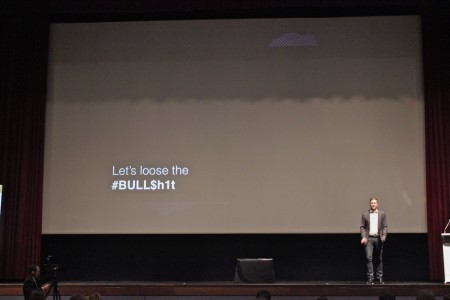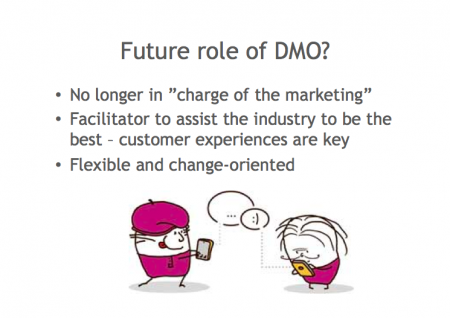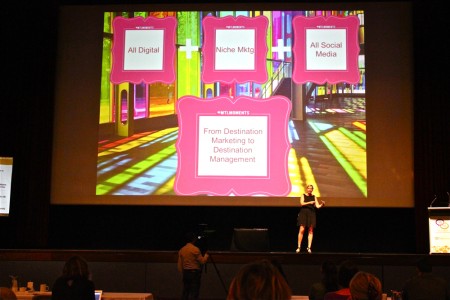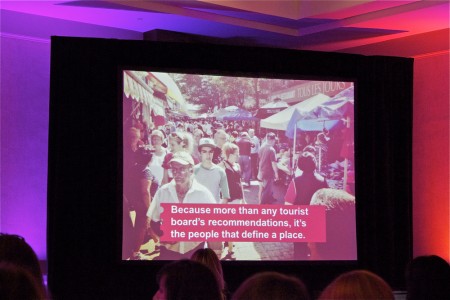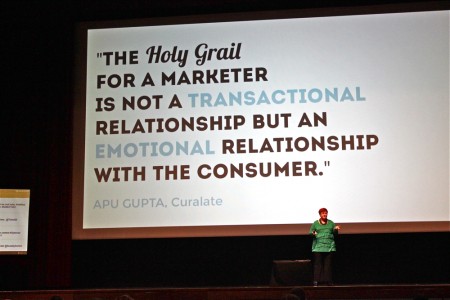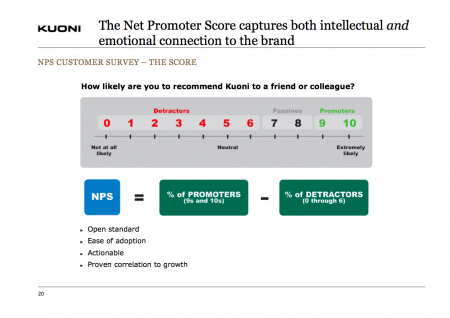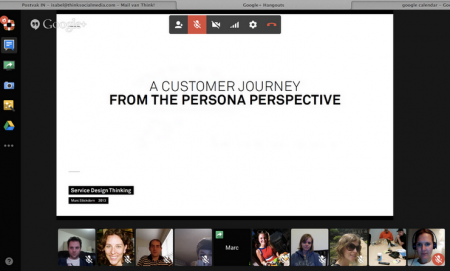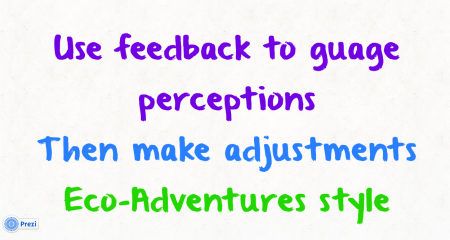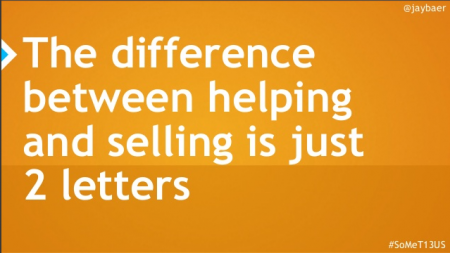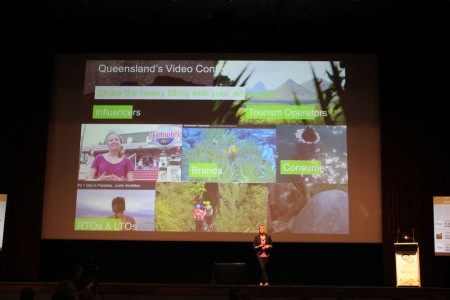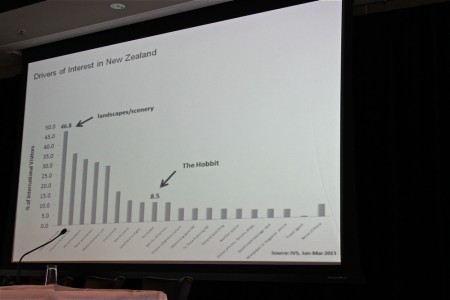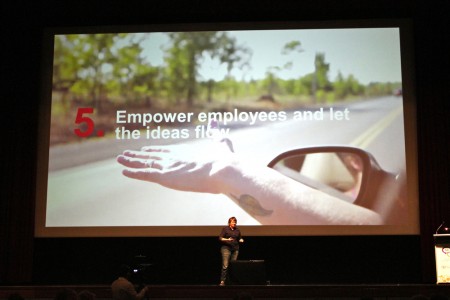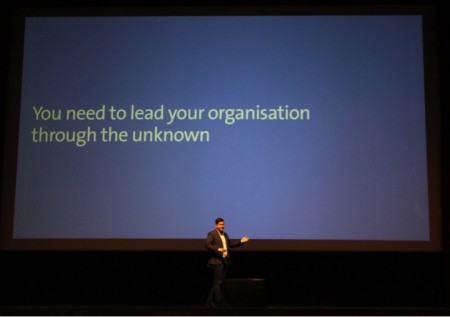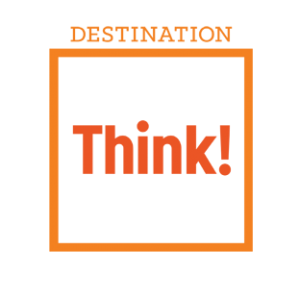(this post was first published on Tnooz)
I attended over a dozen tourism conferences this year on four continents, including our own #SoMeT conferences. Looking back at the pictures I took and the presentations I’ve downloaded, there’s a common thread and it tells a compelling story about the future of the DMO.
Change is needed
William Price – South African Tourism (#SoMeT13AU)
At #SoMeT13AU in Australia, William didn’t mind shaking things up with some provocative quotes including this one. We need to stop doing stuff that doesn’t work and start doing things that do work, and South African Tourism is blazing trails.
What I’ve realized this past year is that we’ve passed the phase where people are skeptical or in denial. We have entered the phase where we are starting to ‘sort out‘ the model, as Clay Shirky calls it. The only things standing in the way are fear, lack of the correct skills and/or not knowing where to start.
The winners aren’t the ones with the biggest budget
Jacques Massardo – Ogilvy Cape Town (#ETAS13)
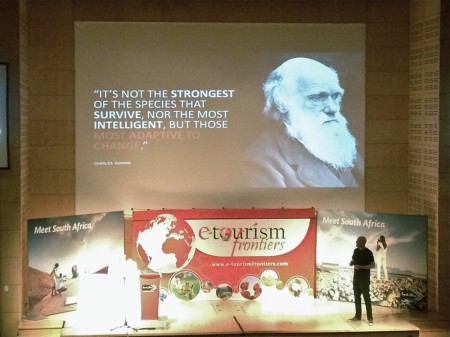
(Please someone correct me if I got the presenter of this slide wrong. I took it at E-tourism Frontiers in Cape Town and forgot who it belongs to.)
I really like this quote because it’s very relevant to what’s going on right now. I see it all around me. The DMOs with the biggest budgets aren’t necessarily the ones who are going to win. They can hide the fact they’re falling behind through big media buys, but there will be a tipping point soon where those who didn’t adapt will have to deal with massive change in a short period of time. And that’s going to hurt. Those who have transitioned and adapted strategically over a period of time will reap the rewards.
By the way, the tipping point is when boards and/or politicians move away from judging activities based on how things look or make them feel, and instead look at the numbers that matter. I’ve started to see early indicators of this already.
The winners are the ones that think outside the box
Heidi Sørvig – Visit Sørlandet (#ENTER2013)
At #ENTER2013 in Innsbruck, Heidi Sørvig from Visit Sørlandet gave a very to the point presentation about how running a DMO in the 21st century really doesn’t have to be that complicated if you’re not afraid to lead, challenge the status quo and make changes.
I’ve been a fan of Heidi’s strategy. It’s very innovative and practical. Her primary KPI is repeat visitation. Because if people come back, it means they like the experience. It also means they will probably recommend the destination to others. She also understands that it’s more efficient to train industry operators about how to manage and market a tourism business than pouring that money into traditional advertising. She has created a program for operators that’s probably the most extensive and sophisticated of any I’ve seen. And all on a small budget.
The winners approach change strategically
Emmanuelle Legault – Tourisme Montréal (#SoMeT13AU)
Tourisme Montréal (a Think! client) has been one of the most innovative DMOs in the ‘big city’ category for years. With leaders like Emmanuelle, TM is not afraid to challenge the status quo, take risks and experiment. I admire her courage because she wants to do what’s right. At #SoMeT13AU, Emmanuelle shared how they’ve been transitioning from a Destination Marketing Organization to a Destination Management Organization over the last few years and how they have dealt with some of the obstacles.
The winners understand to let go of control
Frédérick Ranger – Tourisme Montréal (#SoMeT13US)
Accepting that a DMO doesn’t create a brand, but consumers do was one of the common threads at #SoMeT13US. This is a major shift for many marketers who are used to keeping a brand under tight control. At Tourisme Montréal, one of their guiding principles is to let go. Fred gave a passionate presentation in which he demonstrated how Tourisme Montréal is implementing programs and campaigns that deliver on this principle.
The winners understand the consumer
Donna Moritz – Social Media Strategist at Socially Sorted (#SoMeT13AU)
Donna shared this wise quote from Apu Gupta. What it means is that the transaction will happen as a result of an emotional relationship, and one that grows over a long period of time. It sits at the essence of most modern marketing philosophies including social media, content marketing and permission marketing. In the tourism industry, however, we often seem to be chasing the next “head in bed” or “bum in seat”. Tactics are focussed on the short-term, but we need to take a long-term view to build reputation and loyalty over time.
The winners measure the right things
Andrew Pozniak – Kuoni (#ENTER2013)
Kuoni is a very large luxury travel brand. In many ways they are very traditional, but I’ve seen a few presentations from them now and the way they go about things will set them up perfectly for the future…if they get their online strategy right.
Kuoni places a lot of value in NPS (Nett Promotor Score) and they measure this at different stages of the customer journey. I like this slide because it’s almost identical to one I use. NPS is the best quantitive measure for the overall destination experience. The science behind NPS shows a correlation between NPS score, loyalty, referral and corporate growth. It’s also easy to do.
The winners take charge of designing the destination experience
Marc Stickdorn – Think! Hangout
Marc is one of the real thought leaders for service design. He co-authored a book called This is Service Design Thinking and now runs My Service Fellow and Smaply. I’ve known him for a few years and he was kind enough to do a presentation about service design for the Think! team over Google Hangout. Service Design is a methodology, process and a set of tools that will deliver on this objective, just like Information Architecture, Usability and Interaction Design for websites.
Now that we need to build a brand on the ground, through stories people tell, a DMO needs to design the end-to-end destination experience. By using the dollars typically spent on advertising to work on designing the complete destination experience, people will have a better destination experience. As a result, your NPS score, the stories people tell, repeat visitation and referrals will go up.
The winners build their brand through the experience on the ground
Gregg Sauter – Saskatchewan Roughriders (#HostSK2013)
The Saskatchewan Roughriders (a Think! client) have a strong brand and very loyal following. Gregg explained at Host Saskatchewan that they way they’ve built their brand is primarily around experience. The result is incredible: 2/3rds of all merchandise sales in the Canadian Football League are for his team.
This slide maps some of the touch-points with their customers before the game even starts, from the parking attendant to the stadium host. Mapping the customer journey like this is part of the service design process. It’s the starting point to examine, benchmark and redesign critical touch points where required.
The winners constantly experiment, measure and adjust
Jori Kirk, Cypress Hills Eco-Adventures Ltd (#HostSK2013)
Jori operates an adventure tourism business in Saskatchewan, Canada. I loved his presentation during which he described the keys to his success. As a small business owner, he keeps things simple and focused. He does this by cleverly using technology, offering value while embodying the right corporate values and engaging staff (mostly guides) to empower them and make the experience awesome for the customer. The result is a runaway success.
Jori understands the story his customers what to be part of, how to deliver it and and how to get the story told. If he misses the mark, he will adjust elements to fix the plot of the story.
The winners add real value to the consumer
Jay Baer – author of Youtility: Why Smart Marketing Is About Help not Hype (#SoMeT13US)
Jay Baer‘s message is all about creating value for the consumer. You can’t compete for attention anymore and the best way to gain trust is by adding true value to people’s life. He wrote a good book about it.
It’s not hard to figure out how this applies to travel. Great customer service is key and visitor centres have traditionally facilitated a way for DMOs to deliver it. But customer service has moved outside of those four walls and a roof. Customer service now happens online, on Twitter, Facebook and message boards in all stages of the customer journey.
The winners will engage their network
Sarah “Sos” Mattsson – Tourism and Events Queensland (#SoMeT13AU)
While presenting their online video content strategy for Tourism and Events Queensland at #SoMeT13AU, Sos explained how they have identified key groups of video content producers and described how they fit into their strategy.
It’s important to recognize who the main groups of storytellers are and creating strategies that will help get the best stories out there. It’s also a great way to scale customer service. For example, TripAdvisor destination experts are doing customer service work for free.
The winners market to niches that matter
Catherine Bates, General Manager Brand and International PR, Tourism New Zealand (#TEEC)
Catherine presented Tourism New Zealand’s three-year strategy to leverage the Hobbit movies as a niche marketing opportunity. Even though it’s very traditional (and I wish I could make it social at the core), it’s a perfect example of marketing to a niche audience. For example, Catherine shared the fact that while only 1% of visitors to the city list the Hobbit as a primary reason for a visit, but it still represents $33M.
Focussing on a niche creates big opportunities because you can narrow your focus. Engaging a niche audience via their passions is much easier because it’s very relevant to them. And when you do it right, they will respond by sharing and influencing friends.
The winners empower staff
Kate Duffy – Canadian Tourism Commission (#SoMeT13AU)
Kate described the Canadian Tourism Commission’s social media journey. When a consumer is social, a brand needs to be social as well, and that will ultimately lead to a social business.
A social business will be the end game – we call it a Level 5 DMO. Organizationally, it means letting of the control internally. The rate of change is only going to increase and as the role of the DMO changes and marketing becomes real-time, it’s really important to reduce bureaucracy and empower staff. It might sound scary but you’ll be surprised to what level people will rise to when they feel a sense of responsibility and empowerment.
The winners enable change from within
Jesse Desjardins – Tourism Australia
At #SoMeT13AU Jesse from Tourism Australia shared some of the strategies and approaches to managing the largest DMO Facebook page in the world. It’s very practical and another demonstration that it doesn’t have to be complicated. Just like Kate, Jessie also promoted the fact that it is the responsibility of the people within the organization to champion changes.
For DMO leaders, my advice is to listen to the teams that are running your digital and social platforms. There is an incredible amount of talent out there and you need to use it. I’ve seen good people walk away out of frustration and that hurts all of us. Support your staff and take some risks. Let them create a plan. Park your skepticism, and invest in the future. Learn. And share it with your industry so they understand your new role better. Start the journey so you can manage it over time.
For DMO staff, be an advocate. Find opportunities to create proof of concepts and promote them internally. Help your leaders and your industry understand what is the most efficient and effective way of destination management. Things won’t change by waiting for somebody up top to do the right thing, be pro-active and promote successes.
Conclusion
This year was an exciting year. Many DMOs have done incredible things and I’ve learned so much. I’ve seen many more great presentations I didn’t include here. The future of the DMO is bright, as long as we let go of sacred cows, let go of fear, create a plan to move forward, learn and adjust as we go.
Where to start? Benchmark your current activities, set clear objectives and create a strategy. At a minimum, create a plan for next year to start moving in the right direction.
